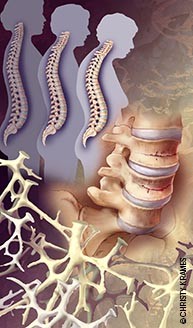Peer Reviewed
Feature Article Geriatrics
Osteoporosis in frail older people
Abstract
Frail older people have increased risks of osteoporosis, falling and fracture. Treatment approaches include strategies aiming to decrease the risk of subsequent fracture and minimise the escalation of frailty.
Key Points
- Frail older people have reduced physiological reserves, often in multiple systems, and advanced stages are marked by reduced mobility and quality of life and increased mortality. Osteoporosis often accompanies advanced frailty and the loss of bone tissue and propensity to fracture may be considered frailty of the skeletal system.
- Frailty, insufficient physical activity, weight loss and low protein intake are associated with increased risk of osteoporosis, falling and fracture.
- Treatment of frail older people with osteoporosis aims to decrease the risk of subsequent fracture and minimise the escalation of frailty. Pharmacological options for reduction of fracture risk include bisphosphonates, strontium ranelate and teriparatide.
- Nonpharmacological strategies that can be applied almost universally to reduce frailty and falls risk include progressive resistance training, balance training, hip protectors, a nutritionally adequate diet, smoking cessation, moderation of alcohol intake and therapies for depression.
- The most robust results are achieved with centre-based exercise programs, and these programs are the best option for complicated and high-risk individuals. Appropriate home or community exercise programs can be carried out, with instruction and ongoing monitoring, if severe frailty and cognitive impairment are not present.
Purchase the PDF version of this article
Already a subscriber? Login here.

